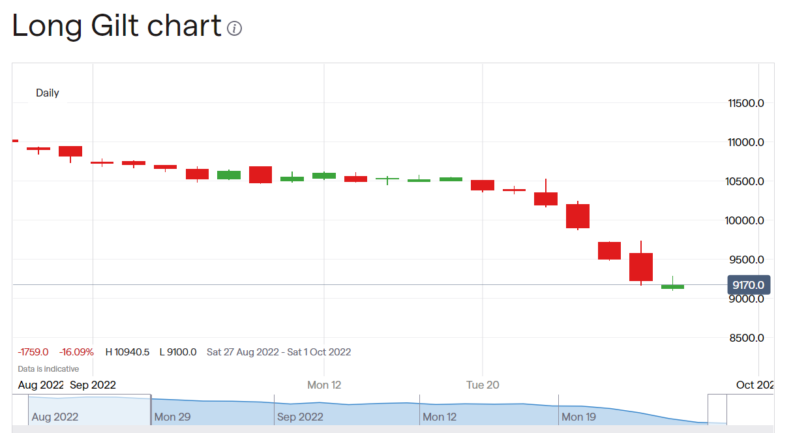Key points:
- Gilts prices are collapsing, yields rising
- Ending QE, interest rate rises, inflation, govt spending, all causing this
- There will be a turning point, the difficulty is when will that be?
UK government bonds – gilts – prices are collapsing – good, they should. Not that that will come as a great comfort to anyone holding any but in terms of the larger economy this is a return to some sort of economic reality after a decade and more of trying to ignore it. But we're traders and investors, not macroeconomists – so, what do these collapsing prices mean for us?
The first thing to really grasp is that bond prices and interest rates – more specifically, the yield on the bond itself – are the inverse of each other. Interest rates go up, bond prices go down, that's just the way it works. So, obviously, sterling interest rates are rising therefore sterling bonds are going down in price. The largest, by far, sterling bonds are government borrowing, those gilts, so government bonds are falling in value. As should also be obvious the long bonds – those with repayment dates 20 and more years into the future – are moving in price more than short ones – bills and notes rather than bonds.
But there's more to it than just rising interest rates. It's also true that inflation is up – so even though nominal interest is going up real interest rates are still negative and by a long way. So, anyone holding gilts – other than the inflation protected ones – is losing money by doing so. “Investments” where losing money is baked into them tend to decline in price.

Also Read: Government Bonds, How To Buy Them In 2022
But, of course, there is more. This past decade has seen the Bank of England buying the gilts necessary to fund the government deficit. This is the process we know as “quantitative easing”. So that there have been hundreds of billions of more gilts in issue hasn't, really, affected the price because they've not been on the market. We get more money out there instead – a useful reason for the inflation. This process is now going into reverse, the BoE is undertaking “quantitative tightening” or QT. At first, as bonds mature it does not reinvest the cash received. Then, next month, it will start actively selling some of its stock into the market – perhaps £80 billion worth. An increased supply of gilts, a lower price for gilts.
And there's yet more. The government has announced that it will cut taxes and also spend some hundreds of billions on the energy crisis and so on. Which, if the BoE isn't buying gilts any more means that there will be many more on the market. More gilts means a lower price for gilts.
So, we might think that gilts will continue to fall – and they might. But at some point the system will turn. Interest rates will – again, at some point – deal with inflation so the coupon on a gilt will be a real return again. Inflation comes down, interest rates go up, that will happen at some point. The energy crisis will be over at some point, government spending might get under control again. At which point gilts prices will start to rise and probably quite strongly. But it won't be when these things happen – it will be when people think they're about to happen. For markets are, of course, forward looking.
So, it's possible to say that the government debt markets, gilts, are an absolute diaster at present. But that worm will turn and they will be an opportunity – the big question is when will that be?
Update: The Bank of England announced Wednesday that it will carry out temporary purchases of long-dated UK Government bonds from September 28.
